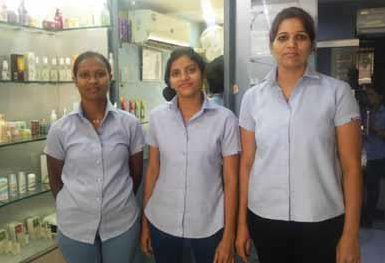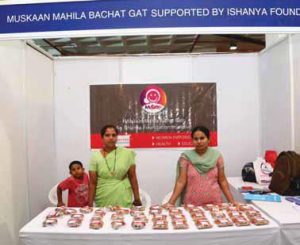
Parul Mehta a successful entrepreneur, social worker and an art connoisseur has become synonymous with many social causes over the years mainly in the arena of women empowerment and income generation programmes for the youth. A CSR initiative of Deepak Fertilisers & Petrochemicals Corporation Ltd, she founded Ishanya Foundation in 2006. A firm believer in creating a self-reliant society, she has worked relentlessly to identify potential and gaps in the economic and social support systems, with special emphasis on youth, women and marginal farmers. Besides running income generation programmes for underprivileged women and various vocational courses, she also organizes several medical camps and initiatives across western India and mobile libraries for schools in rural areas, benefitting more than 2000 girls and women. In conversation with Archana Sinha, Parul Mehta reveals her vision for the women of today.
How long have you been involved and developing programmes for community development?
 Community has always been close to my heart right from my young days. I was involved in various projects related to community services. Ishanya Foundation came in much later, in 2006.
Community has always been close to my heart right from my young days. I was involved in various projects related to community services. Ishanya Foundation came in much later, in 2006.
A lot is being done and changes are also now visible in the marginalised sections of society. However, very little changes have been noticed among the women and their situation, their mindset, their negligence by the other members of the society, and their education is still not given much importance in general. How do you think rapid and visible change can be seen?
The CSR Mandate of 2013 by the Govt. of India has brought a definitive focus to CSR for corporates, institutions, NGOs and the public in general. Inclusivity and diversity now feature as main topics of discussions and work areas that most Corporates are imbibing, enabling issues of women empowerment to be addressed.
We primarily focus and address issues of women and their families. Our reach to these women has increased year on year primarily through our skill and service-based vocational training programmes and also through our livelihood enhancement through entrepreneurship development programmes. There is a distinct and visible movement towards empowering women, and unlike yesteryears, women are now coming forward and are focusing on being successful and supporting their families.
What motivated you to set up Ishanya Foundation?
I have always felt the need to give back to society, following the old adage– “It is better to give than to receive”. The Foundation provided me with this platform and act as a catalyst in my endeavour along with my team to create a self-reliant society in the communities we work in.
How do you address the issues of women empowerment through the Foundation?
Measures of outcome and impact are critical to mark the success of any programme. In our endeavour to ensure sustainability, skill enhancement and empowering women in our initiatives, continuous assessment and tracking the progress of our beneficiaries, even post employability, enables us to gauge and encourage them to achieve their goals set out in associating with Ishanya Foundation
 Every project initiated at Ishanya Foundation has been carefully chosen to address all issues of women empowerment which is also our main area of concern and focus.
Every project initiated at Ishanya Foundation has been carefully chosen to address all issues of women empowerment which is also our main area of concern and focus.
Along with my committed team, we ensure that encouragement, enrichment, compassion, confidence and enhancement are some of the measures we imbibe for reducing inequalities faced by women socially and economically. We ensure that through our programs, these women are able to earn a secondary source of income to enhance their skills and standard of living thus aiding in reducing some of the issues faced by them.
A skewed mindset, tradition of giving the male child more importance, lack of education and awareness of self, lack of health care and nutrition are some of the obstacles to women development and empowerment. How do you address these issues?
 You are absolutely right about the importance given to the male child. It is widely prevalent, especially in certain strata of the society. However, due to rapid penetration and awareness of social media, our inclusive and diverse programmes coupled with counselling at all stages and awareness drives have helped women change and therefore give equal importance to the girl child.
You are absolutely right about the importance given to the male child. It is widely prevalent, especially in certain strata of the society. However, due to rapid penetration and awareness of social media, our inclusive and diverse programmes coupled with counselling at all stages and awareness drives have helped women change and therefore give equal importance to the girl child.
Do share with us about Yellow Ribbon NGO Fair and Heart to Hand website and their growth over the years.
Ishanya Foundation is targeted towards empowering women, enabling them to earn a secondary source of income to enhance their livelihood. The Foundation initiated a programme of recycling old fabric into cloth bags completely made by underprivileged women through appropriate training. This was a novel idea to protect and safeguard the environment. In time, we added an array of items to our product list and realised that these products were beautifully made, but the women lacked definitive channels to market these products to the right target audience. Many other NGOs also faced a similar situation.
 After considerable deliberation, we came up with the idea of a Fair that would focus on promoting the NGOs and SHGs supporting a multitude of causes like cancer patients and physically handicapped children etc. Thus The Yellow Ribbon NGO Fair was born which, in its first year in 2007, had 49 NGOs participating; and for the last two years, we have had to restrict this to 110 NGOs and artisans from across India.
After considerable deliberation, we came up with the idea of a Fair that would focus on promoting the NGOs and SHGs supporting a multitude of causes like cancer patients and physically handicapped children etc. Thus The Yellow Ribbon NGO Fair was born which, in its first year in 2007, had 49 NGOs participating; and for the last two years, we have had to restrict this to 110 NGOs and artisans from across India.
The Heart to Hand website followed suit wherein we were able to collate and come up with a compendium of 200 NGOs across eight cities of India to showcase over 400 products that could be made available all year round. The people of Pune city welcomed this initiative and support us whole-heartedly. It is because of them that we have been able to continue this initiative for many years now.
Do you also have some methods of finding out if there is a trickledown effect of prosperity among the local women who are a part of these NGOs or your projects?
 Measures of outcome and impact are critical to mark the success of any programme. In our endeavour to ensure sustainability, skill enhancement and empowering women in our initiatives, continuous assessment and tracking the progress of our beneficiaries, even post employability, enables us to gauge and encourage them to achieve their goals set out in associating with Ishanya Foundation.
Measures of outcome and impact are critical to mark the success of any programme. In our endeavour to ensure sustainability, skill enhancement and empowering women in our initiatives, continuous assessment and tracking the progress of our beneficiaries, even post employability, enables us to gauge and encourage them to achieve their goals set out in associating with Ishanya Foundation.
Tell us about project Muskaan and its role in empowering financially challenged women.
Muskaan is one of our most innovative and successful initiatives. It provides an additional source of income to financially challenged women (Muskaan Parees). The Foundation receives pre-owned garments and accessories through the Muskaan Ambassadors in the city. These products are checked for quality and then sold by the Muskaan Parees, thus enabling them to earn additional source of income. Stalls are set up by them year round at the communities, at The Yellow Ribbon NGO Fair and at leading hospitals like Ruby Hall Clinic, Jehangir, etc. They are thus successful in generating a huge turnout in terms of sale of garments and generation of income.
A lot has been achieved, yet one may feel that a lot is yet to done. What are your future plans regarding empowerment of women from various sections of the society?
I don’t think we can ever say we have done enough for our society and those in need. We will continue to strive through innovative measures to reach out to as many women and their families to make that marked difference to their lives. We have some new programmes coming up that will give bolster our womenfolk even more.
In closing, would you like to share your thoughts on something that has influenced and spurred you to go on?
Edith Wharton, Pulitzer Prize-winning American novelist, short storywriter and designer rightly quoted: “There are two ways of spreading light – Be the candle or the mirror that reflects it.” We will continue to be catalysts of inclusive growth and will pursue our committed focus to the development sector to ensure issues of women empowerment, health and education are rightfully addressed.

